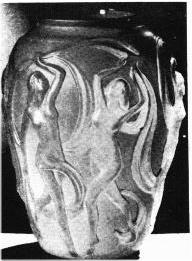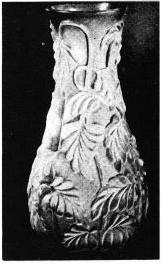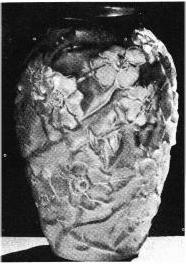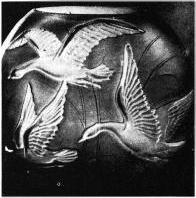National Depression Glass Association
Preserving America's Glass Manufacturing Heritage
Fantastic Figurines
by Mary Van Pelt
Glass Review - January 1978
The early part of the century was perhaps one of the most prolific eras for the
designs and creations of Reuben and Kenneth Haley. ln 1923, U. S. Glass was sold
 to the control of a steel man by Mr. Bryce, (then president and brother of the
Bryces in Mt. Pleasant.) Reuben was offered, but refused, the presidency and resigned
to set up a consultant service with offices and shop in Coraopolis, Pa., at the
Consolidated Lamp and Glass Company. Here for a short time his son Kenneth worked under
his tutelege before joining the technical service of the Glass Machine Division in
Cleveland from where he went to Phoenix at Monaca, Pennsylvania., as designer and development
engineer. lt was at this time that Reuben also did a fantastic line of designs for the
Gill Caly Pottery Company of Muncie, Indiana.
to the control of a steel man by Mr. Bryce, (then president and brother of the
Bryces in Mt. Pleasant.) Reuben was offered, but refused, the presidency and resigned
to set up a consultant service with offices and shop in Coraopolis, Pa., at the
Consolidated Lamp and Glass Company. Here for a short time his son Kenneth worked under
his tutelege before joining the technical service of the Glass Machine Division in
Cleveland from where he went to Phoenix at Monaca, Pennsylvania., as designer and development
engineer. lt was at this time that Reuben also did a fantastic line of designs for the
Gill Caly Pottery Company of Muncie, Indiana.
From the minds of Reuben and Kenneth, the designs of nature and figurals poured
forth, to be utilized on the beautiful vases produced by Consolidated, one of the
finest glass works of that period. The first photo (at right) is the Dancing Girl vase, originally  modeled while Kenneth was with his father, but not produced and marketed by
Consolidated until after Reuben's death by Kenneth. Although designed earlier, it was
produced in 1927, becoming a part of Kenneth's line he named REUBEN in honor
and memory of his father. lt came in colors of brown honey, cocoa gold, shadow
tan and gold. The cameo decoration was white and pink. In 1933, Phoenix
produced it but discontinued it in 1948. In the late 60's, Ken had Phoenix reproduce
it for him to market through his own K. R. Haley Glassware Co., Inc., of
Greensburg, Pennsylvania.
modeled while Kenneth was with his father, but not produced and marketed by
Consolidated until after Reuben's death by Kenneth. Although designed earlier, it was
produced in 1927, becoming a part of Kenneth's line he named REUBEN in honor
and memory of his father. lt came in colors of brown honey, cocoa gold, shadow
tan and gold. The cameo decoration was white and pink. In 1933, Phoenix
produced it but discontinued it in 1948. In the late 60's, Ken had Phoenix reproduce
it for him to market through his own K. R. Haley Glassware Co., Inc., of
Greensburg, Pennsylvania.
Photo No. 2 (at left) is Kenís Philadendron design, circa 1930. Phoenix produced it in
1931 in colors of green shadow, green and honey. 1939 saw it discontinued until it
was re-introduced by the K. R. Haley Glassware Co., in 1948. Once more it was
withdrawn from production. In 1976, Phoenix began reproducing it once more.

Photo No. 3 (at right) is the Wild Rose pattern, designed by Reuben in 1925. It was produced by Consolidated in lilac and green-rose. This design was revived by Phoenix in 1933, again by the K. R. Haley Glassware Co., in 1948, to be discontinued about 1952.
Photo No. 4 (below, left) is the Wild Geese vase, designed by Kenneth, circa 1931 and produced by Phoenix in green shadow. Ken had Phoenix reproduce them in 1948 in
green shadow, with 1970 seeing Phoenix producing them again in green and tan
cameo.

The Dancing Girl vase molds were acquired by Ken from Consolidated for the Phoenix Glass Co., from 1928-1934, the years he worked for them. Ken had an official contract to designate this particular vase as a part of his REUBEN line, together with the Wild Rose vase. All these vases, hand blown and exquisitely modeled relief designs are erroneously becoming labeled as Phoenix designs and creations. While Phoenix has reproduced them, few know these go back before Phoenix made them, to another company and earlier time.